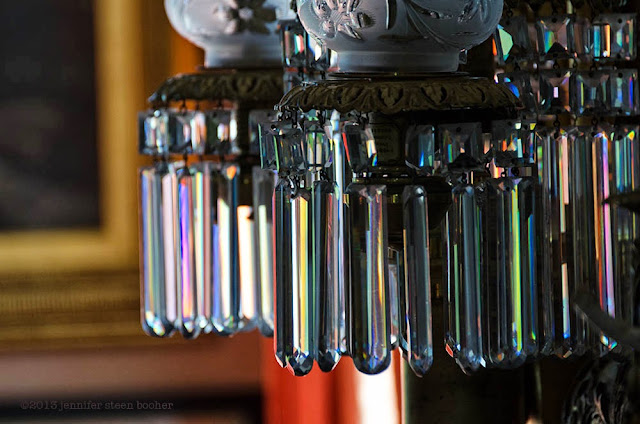On Saturday we visited Woodlawn Museum, which everyone I know calls The Black House, a reference to its former owners, the Black family. This is a local habit I find endearing - the tendency to refer to places by long-gone names. You'll get directions to "turn left at the cheese house" (the cheese house closed about thirty years ago) or "just past Crab Corner" (named for a crab-picking business that closed at least fifteen years ago) and so on. There's even a "Raggedy Ass Corner" where there was once a tumbledown old house with a yard full of junk (now heavily wooded with no trace of the house.) Polite people call it "R.A. Corner." I've picked up the habit myself, and still refer to our grocery store as "Don's" even though Don sold it to Hannaford years ago (as does everyone else who pre-dates that sale. It's one way to tell when people moved to town.)
But back to the Black House... The house was built by one Colonel John Black in the 1820s. The Black family lived there for three generations and left it to the town to be run as a museum in 1929. (And people still call it the Black House when it's been "Woodlawn" for 80-something years...I wonder if our house will ever be "the old Booher place.")
The house is stuffed with the original furniture, china, rugs,
knicknacks, and commodes. There's a lovely curving staircase in the
central hall, which was impossible to photograph without a wider angle lens, and some interesting architectural features. There's also an enormous four-poster bed which we were told is the oldest bed in the U.S. that is still in its original room and has its original hangings, which is impressive, but I just couldn't get excited about that, because I have asthma and all I can think of when I see bed canopies is the dust mites.
This is not the famous bed, but it did make me think of dust mites.
The last owner, the third generation of Blacks, seems to have been caught up in the Colonial Revival movements of the 1880s and 1920s. I picture him poking through the attics looking for his grandparents' furniture (which was the genuine article) and polishing the family portraits of Generals Washington and Cobb (Cobb was an ancestor, Washington was a friend of his) before leaving the whole caboodle to the town of Ellsworth.
There are some wonderful portraits. I think that's General Cobb up above, and it might be Frances Black below, but then again, it might not. Whoever she is, isn't her lace collar amazing?
A few last details from the house:
This is called a lithophane. It's molded ceramic, believe it or not, and the light shining through the thinner parts works kind of like a negative. Learn more here. 

I don't often envy the original occupants of historic houses (have you ever tried to keep warm in a large room heated only by an open fireplace?) except in their pantries. I'm often consumed with jealousy over their storage. The Blacks had three sets of china, and according to the guide, the blue-and-white ware was for breakfast, the Canton ware (seen above) was for luncheon, and the um, other, more-colorful-set-which-did-have-a-fancier-name was for dinner. Three full sets of china and the shelves upon which to store them? Envy. And the other side of the pantry had three shelves of glassware. More envy. Turning green. Must go admire my indoor plumbing and pat my baseboard radiators.










I loved that blogpost!What a great tour guide you are ! The lace painting is amazing!AriadnefromGreece!
ReplyDelete